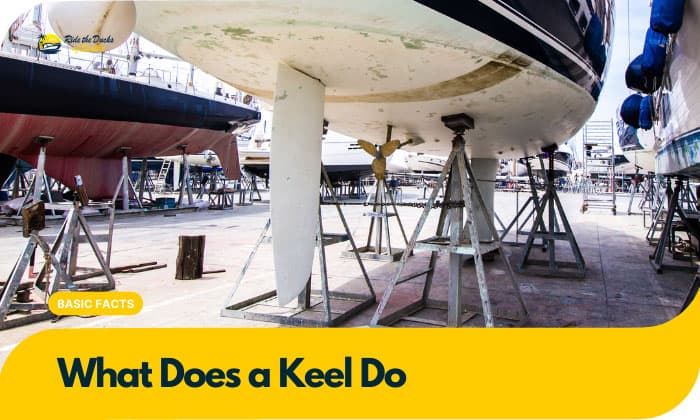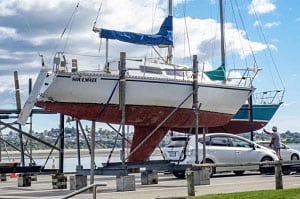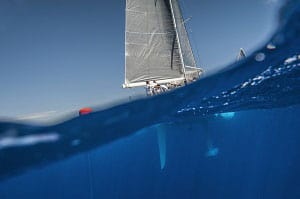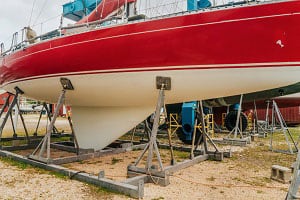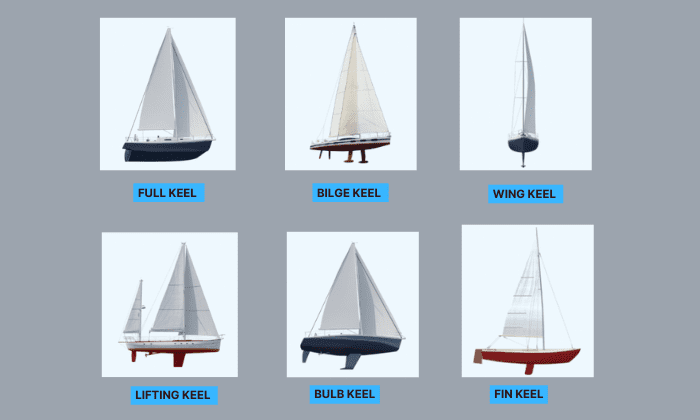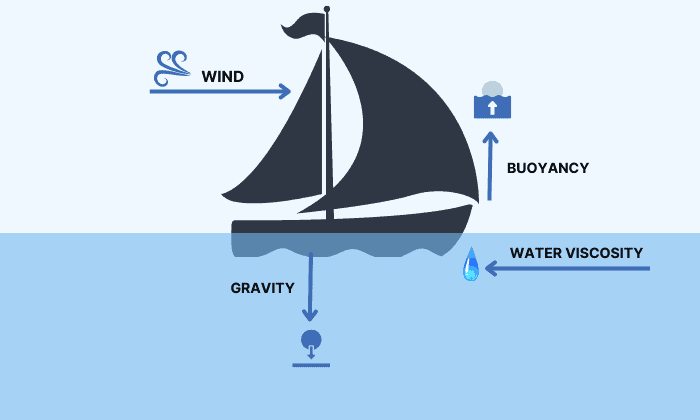As the keels are always submerged when the boat is in water, they are often overlooked or forgotten. However, did you know that the keel actually plays an important role in supporting the ship’s performance?
So, what does a keel do? To put it simply, this hydrodynamic component helps other boat parts keep the watercraft afloat, even in rough waters.
For example, a sailboat keel prevents the vessel from tipping to the side by strong winds while also accommodating ballast tanks for maintaining the boat’s buoyancy.
Please keep reading to learn more.
Table of Contents
Understanding the Keel
In this section, we will learn more about one of a boat’s most significant hydrodynamic features – the keel.
1. What is a keel?
Let us define keel. In nautical terms, the keel is the boat’s principal structural member. As the backbone of the boat, this hydrodynamic component is in the center of the boat hull’s bottom and runs lengthwise. You can liken the keel to the human’s spine.
So, does that mean all boats have a keel?
Well, yes and no. Everything depends on how you define a keel.
For example, the traditional keel refers to a boat’s structural member, which other supporting structures connect to. It is like the human spine that holds the ribs.
Hence, if a boat has a structure that holds other structural components or ribs, it has the “backbone keel.” However, some vessels do not have a central structure for connecting “ribs.” That is why they do not have a keel.
The keel of a ship almost everyone is familiar with is the vertical plane structure extending from the boat’s bottom hull, as commonly seen in sailboats.
So, what is the function of the keel? Read on to find out!
2. What is the purpose of a keel?
The main purpose of a boat’s keel is to resist wind and other forces pushing the vessel to one side. In other words, it keeps the sailboat from capsizing, even in strong winds.
So, how does a keel work in this respect (lateral resistance)?
Let us imagine a sailboat. The visible section above the waterline comprises the upper hull, deck, sail, and associated structures. The components we do not see (underwater) are the lower hull, keel, and rudder.
Now, focus on the sail and the keel. The sail catches the wind to move the vessel. If the wind blows sideways, the sailboat can “turn” or “heel” on its side in the wind’s direction.
The keel counters the wind effect on the sail. When the wind pushes the sail to one side, the keel counteracts the boat’s sideway movement to prevent it from tipping.
Sailboats and yacht keels also generate “lift,” allowing vessels to move forward as efficiently as possible.
Lastly, some keels house a ballast tank to ensure boat stability, preventing the vessel from capsizing.
3. What does a keel look like?
The traditional keel shape follows the boat hull’s natural contours. It is a “flat blade” jutting out of the center of the boat’s bottom like a fish’s ventral fins protruding on its belly’s underside.
Non-sailing boat keels follow the bottom hull’s shape. For example, some cruise liners and cargo ships have an angled longitudinal keel parallel to the deck. Others have reinforced hull bottoms serving as the keel.
On the other hand, river ferries, tugboats, and trawlers feature a rectangular bar keel.
4. Where is the keel on a boat?
An integral aspect of appreciating the keel definition is knowing its precise location. This hydrodynamic component is the marine equivalent of an airplane’s vertical tail stabilizers. The only difference is it is underwater.
Imagine a sailboat out of the water, and let’s look at it from the side. The keel of a boat starts at the hull’s bottom-most part and extends vertically downward.
Now look at the boat from the front. The keel boat part will be centerline, dividing the vessel into the port (left) and starboard (right) halves. Unsurprisingly, the keel’s location makes it a ship’s backbone or spine. Now, that is another worthy keel meaning.
5. How deep should a keel be?
Keel depth can be as shallow as a foot or as deep as eight feet, depending on the keel type and boat length. For example, a 20-foot sailboat with a full or deep keel only has a keel depth of 2 feet, while sailboats at least 26 feet long can have a keel depth of 3 feet and 3 inches.
Meanwhile, a wing-type keel can have a keel depth of 6 feet (for boats up to 26 feet long) or 8 feet (for vessels at least 40 feet long). A bilge keel is the shallowest—at 1 foot (<20-foot boats) to 2 feet (<40-foot watercraft).
6. How heavy should the keel be?
Here is a definition of keel structures that will blow your mind. Boat keels can be as heavy as 12,000 pounds or as light as 200 pounds, depending on vessel length, keel type, and usage.
For example, a 40-foot sailboat weighing 30,000 pounds can have a keel weight of 12,000 pounds. Meanwhile, a 400-pound 15-footer can have a 160-pound keel.
Here is where it gets crazy. A sailboat’s keel accounts for the vessel’s 35 to 45 percent overall weight. So, you can estimate your boat keel’s heft if you know the vessel’s weight.
For example, suppose you have a 22,000-pound sailboat. Following the rules stated above, we can calculate that the keel’s weight is around 7,700 to 9,900 pounds.
7. What material comprises the keel?
Keel designs are an integral aspect of boat or ship design. Hence, the keel and the hull would be made of the same material.
For instance, we can expect the keel to feature aluminum if the boat’s hull and other principal construction feature this material. The only keel component with a different material is the ballast, mostly featuring lead.
Traditional boat-builders use the sturdiest material available for the keel. Age-old nautical tradition dictates laying the keel as a cause for celebration because it lays the foundation for the whole ship. After all, no boat manufacturer wants to create a vessel prone to ship keel damage.
Types of Boat Keel
Boat keels come in several types.
- Full keel – Sailors know this long keel as the “ballast keel,” a narrow-V-shaped vertical extension protruding from the boat’s bottom hull along the centerline.
- Bilge keel – This type is like a fish’s pectoral fins because the keel plates project from the boat’s sides and are parallel to the backbone or central keel. Its purpose is to prevent rolling.
- Fin keel – This keel type is like a full keel, except it is only positioned in amidships near the center of the boat. It resists lateral forces or “heeling” moments.
- Bulb keel – You can easily recognize bulb keels due to their ballast-filled bulb, resembling a teardrop. They’re used almost exclusively on offshore racing watercraft.
- Wing keel – This keel type has horizontal blades fixed to a vertical plane. It is like a fin keel but with extra “wings” on the sides for better clearance, especially in shallow waters.
- Lifting keel – Also known as the “swing keels”, lifting keels are retractable thanks to a slot in the vessel, allowing the boat to improve its lateral resistance. Position-wise, they’re almost the same as fin keels—which are fixed and non-retractable.
What Forces Can Affect a Sailboat
Sailboats are elegant vessels. However, they are also some of the most challenging to pilot. Sailing captains must balance four factors to keep their watercraft afloat.
- Wind – Air movement is a sailboat’s natural power source, allowing it to move on the water like a motor propelling a boat forward.
- Water viscosity – As a rule, the “denser” the water, the more force the boat needs to move on the water. This factor “slows” the sailboat, increasing resistance.
- Gravity – This invisible force pulls the sailboat downward. Without gravity, the boat wouldn’t be submerged in the water, meaning it wouldn’t be able to move at all.
- Buoyancy – A sailboat’s buoyancy reflects its ability to push itself against gravity’s pull. Buoyancy is what keeps the vessel afloat.
These factors interact with the sailboat. For example, the wind often blows sideways. Hence, the vessel must convert this “leeward” force into forward motion.
Meanwhile, the ballast in the keel keeps the sailboat afloat and helps generate “lift.” It also counters the sailboat’s “heeling” motion by generating opposing lateral forces.
FAQs
What is a boat without a keel called?
A small keel-less sailboat is a “dinghy.” Although it has a daggerboard or a centerboard, a dinghy does not have a ballast or keel. You will also not see a keel on a canoe.
Do all sailboats need/have a keel?
Not all sailboats have a keel. For example, small sailboats (i.e., dinghies) and multi-hulled sailing vessels (i.e., catamarans and trimarans) do not have keels. Adding a keel to multihulls is redundant because both designs provide stability.
Conclusion
“What does a keel do?” Sailboat keels resist wind-associated heeling motions, preventing the vessel from rolling on its side. Keels also facilitate lift, allowing the watercraft to optimize wind power for locomotion. Lastly, keels contain ballasts necessary for ensuring maximum boat stability.
Of course, various keel types can provide other functions. Some keels protect the rudder and propeller, while others allow the boat to tread shallower waters without causing instability.

Ten years of enjoying countless trips on boats never made me love them any less! So I am here to put all those experiences into good use for other boaters who want to have a safe and fun trip with their friends and families.

